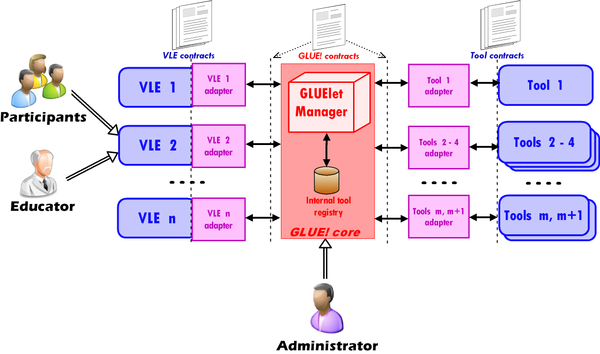Group Learning Uniform Environment: Difference between revisions
m (→Introduction) |
m (→Architecture) |
||
| (9 intermediate revisions by the same user not shown) | |||
| Line 9: | Line 9: | ||
GLUE! allows educators to control the creation and configuration of external tool instances within VLEs and their automatic assignment to VLE users depending on their roles and the groups they belong to; that reduces the time and complexity required to instantiate non-trivial collaborative learning situations within VLEs. Afterwards, students logged in the VLE find their corresponding tool instances; That facilitates the enactment of collaborative learning situtations.}} | GLUE! allows educators to control the creation and configuration of external tool instances within VLEs and their automatic assignment to VLE users depending on their roles and the groups they belong to; that reduces the time and complexity required to instantiate non-trivial collaborative learning situations within VLEs. Afterwards, students logged in the VLE find their corresponding tool instances; That facilitates the enactment of collaborative learning situtations.}} | ||
([http://www.gsic.uva.es/glue/ GLUE! home page], retrieved April 2014) | ([http://www.gsic.uva.es/glue/ GLUE! home page], retrieved April 2014) | ||
Glue was developed mostly by Carlos Aliro Hoyos in a [http://www.gsic.uva.es/uploaded_files/53800_PhDThesisCarlosAlarioHoyos.pdf PHD thesis] | |||
See also: | |||
* [[GLUE!-PS]], a sister project | |||
== Architecture == | |||
{{quotation|The leftmost and rightmost GLUE! tiers make use of the well-known adapter pattern | |||
[Gam95] to respectively wrap VLEs and tools, also adapting their specific and heterogeneous | |||
contracts to two generic and homogeneous intermediate contracts: the GLUE! integration contract | |||
for tools, and the GLUE! integration contract for VLEs; these contracts are detailed in | |||
sections 3.4.2 and 3.4.3. These type of software adapters, which were also employed in some | |||
recent two-tier research integration works (e.g. IMS LTI or Basic LTI) to enable the integration | |||
of VLEs and tools without modifying their implementations, are called VLE adapters and | |||
tool adapters in the GLUE! architecture.}} (Alario Hoyos 2012:75) | |||
[[File:GLUE-architecture.png|600px|thumbnail|none|Overview diagram of the GLUE architecture, [http://www.gsic.uva.es/uploaded_files/53800_PhDThesisCarlosAlarioHoyos.pdf Hoyos (2012:75)] ]] | |||
Picture of the reference implementation presented in Hoyas (2012) | |||
[[File:GLUE-architecture1.png|600px|thumbnail|none|Overview of GLUE!-RI including: the GLUElet Manager, three VLE adapters (Moodle, LAMS, MediaWiki) and nine tool adapters (Google Docs, MediaWiki, Dabbleboard, Apache Wookie, Doodle, Facebook Live Stream, Kaltura, Noteflight, web content). Source [http://www.gsic.uva.es/uploaded_files/53800_PhDThesisCarlosAlarioHoyos.pdf Alario Hoyos (2012:117)] ]] | |||
== Links == | == Links == | ||
* [http://www.gsic.uva.es/glue/ Home page] | |||
== Bibliography == | == Bibliography == | ||
| Line 18: | Line 39: | ||
* Carlos Alario-Hoyos, Miguel L. Bote-Lorenzo, Eduardo Gómez-Sánchez, Juan I. Asensio-Pérez, Guillermo Vega-Gorgojo, Adolfo Ruiz-Calleja, GLUE!: An architecture for the integration of external tools in Virtual Learning Environments, Computers & Education, Volume 60, Issue 1, January 2013, Pages 122-137, ISSN 0360-1315, [http://dx.doi.org/10.1016/j.compedu.2012.08.010 10.1016/j.compedu.2012.08.010]. | * Carlos Alario-Hoyos, Miguel L. Bote-Lorenzo, Eduardo Gómez-Sánchez, Juan I. Asensio-Pérez, Guillermo Vega-Gorgojo, Adolfo Ruiz-Calleja, GLUE!: An architecture for the integration of external tools in Virtual Learning Environments, Computers & Education, Volume 60, Issue 1, January 2013, Pages 122-137, ISSN 0360-1315, [http://dx.doi.org/10.1016/j.compedu.2012.08.010 10.1016/j.compedu.2012.08.010]. | ||
* Carlos Alario Hoyos (2012). Dpto. de Teoría de la Señal, Comunicaciones e Ingeniería Telemática, Escuela Técnica Sup erior de Ingenieros de Telecomunicación, Universidad De Valladolid. ''GLUE!: An Architecture for the Integration of External Tools in Virtual Learning Environments''. PHD thesis, [http://www.gsic.uva.es/uploaded_files/53800_PhDThesisCarlosAlarioHoyos.pdf PDF] | |||
[[Category: Workflow]] | [[Category: Workflow]] | ||
Latest revision as of 18:43, 2 April 2014
Introduction
GLUE! is a middleware architecture that allows a lightweight integration of existing external tools in existing Virtual Learning Environments (VLEs) like Moodle or LAMS.
GLUE! is composed of three kinds of loosely-coupled distributed services: the GLUE! core, and two sets of adapters (VLE and tool adapters). While the GLUE! core supports most of the integration functionality, VLE and tool adapters wrap existing VLEs and tools, connecting them to the GLUE! core.
GLUE! allows educators to control the creation and configuration of external tool instances within VLEs and their automatic assignment to VLE users depending on their roles and the groups they belong to; that reduces the time and complexity required to instantiate non-trivial collaborative learning situations within VLEs. Afterwards, students logged in the VLE find their corresponding tool instances; That facilitates the enactment of collaborative learning situtations.(GLUE! home page, retrieved April 2014)
Glue was developed mostly by Carlos Aliro Hoyos in a PHD thesis
See also:
- GLUE!-PS, a sister project
Architecture
“The leftmost and rightmost GLUE! tiers make use of the well-known adapter pattern [Gam95] to respectively wrap VLEs and tools, also adapting their specific and heterogeneous contracts to two generic and homogeneous intermediate contracts: the GLUE! integration contract for tools, and the GLUE! integration contract for VLEs; these contracts are detailed in sections 3.4.2 and 3.4.3. These type of software adapters, which were also employed in some recent two-tier research integration works (e.g. IMS LTI or Basic LTI) to enable the integration of VLEs and tools without modifying their implementations, are called VLE adapters and tool adapters in the GLUE! architecture.” (Alario Hoyos 2012:75)

Picture of the reference implementation presented in Hoyas (2012)

Links
Bibliography
- Carlos Alario-Hoyos, Miguel L. Bote-Lorenzo, Eduardo Gómez-Sánchez, Juan I. Asensio-Pérez, Guillermo Vega-Gorgojo, Adolfo Ruiz-Calleja, GLUE!: An architecture for the integration of external tools in Virtual Learning Environments, Computers & Education, Volume 60, Issue 1, January 2013, Pages 122-137, ISSN 0360-1315, 10.1016/j.compedu.2012.08.010.
- Carlos Alario Hoyos (2012). Dpto. de Teoría de la Señal, Comunicaciones e Ingeniería Telemática, Escuela Técnica Sup erior de Ingenieros de Telecomunicación, Universidad De Valladolid. GLUE!: An Architecture for the Integration of External Tools in Virtual Learning Environments. PHD thesis, PDF